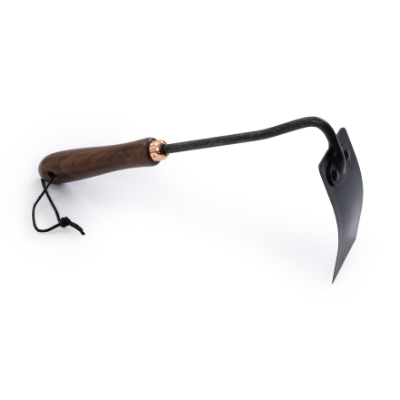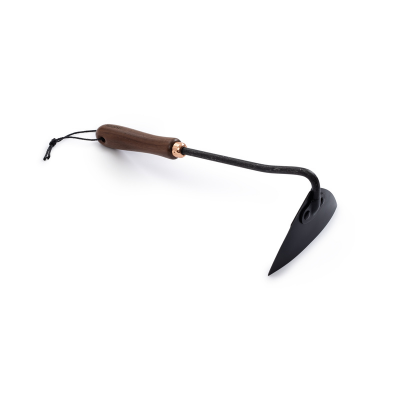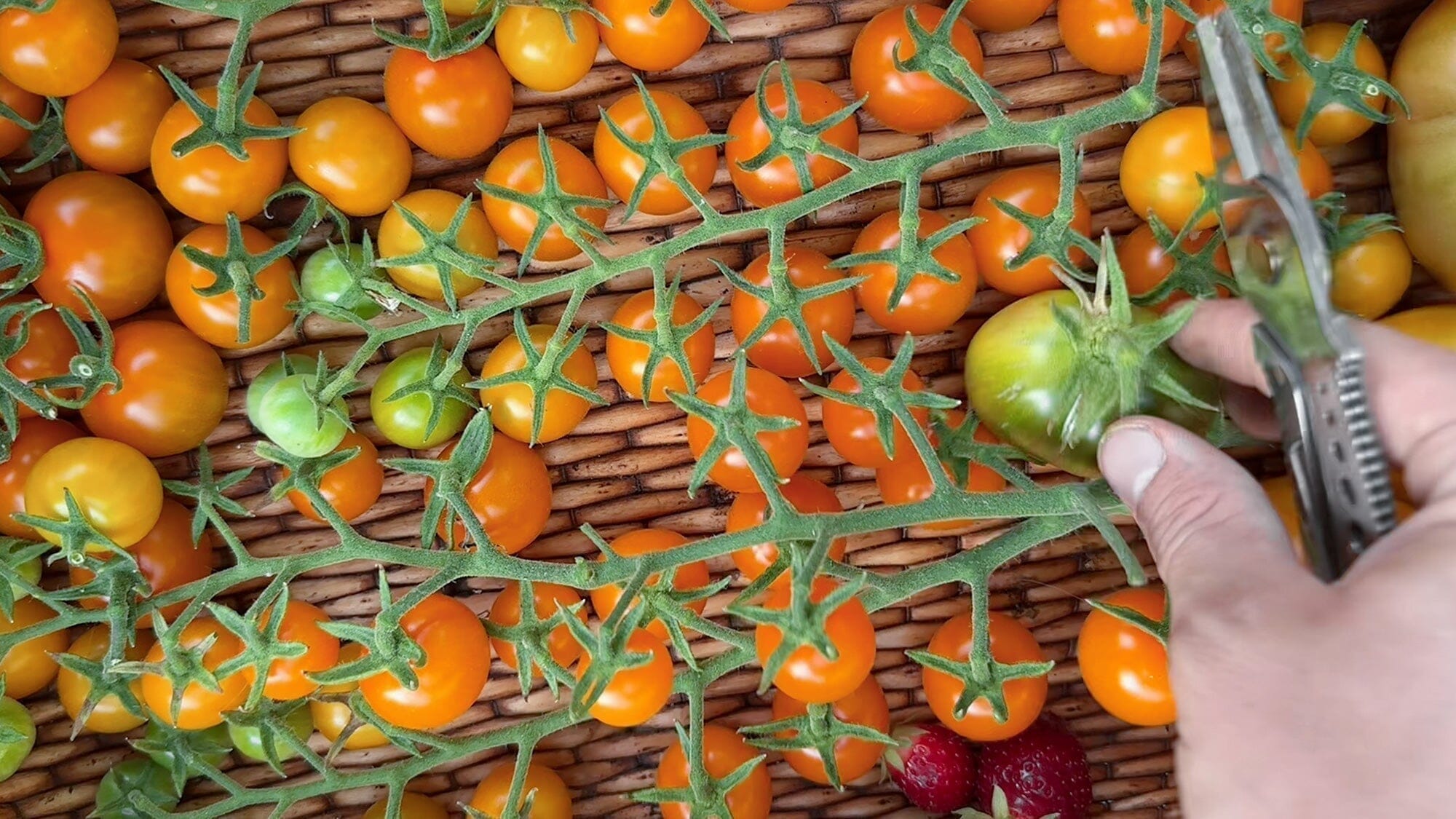 |
How to use a hand trowelTrowels are incredibly handy for digging in small spaces. The narrow, slightly scooped blade is perfect for installing bedding plants, moving soil, and digging holes for seedlings. A trowel is an essential tool in every gardener's arsenal. |
 |
How to use a square hoeThe square hoe will quickly become one of the most used tools in your kit. It’s a wonderful trencher, hiller, and soil-patter. Use the square hoe to dig a long trench (where seeds or transplants will be planted) in a row-like fashion. Hill up the soil over the seeds or around the seedling roots. Then use the flat side of the hoe to gently pat the soil down around the plant, stabilizing the seeds and roots. Potato plants need to be continuously covered by a hill of soil throughout the season. When tending to potato crops, use the edge of the hoe to scoop and hill soil in a mound over the plant. The square hoe is an excellent tool for moving soil to maintain garden bed borders and rows. |
 |
How to use a triangle hoeJust like a square hoe, the triangle hoe has a variety of uses for all types of gardeners. This is a great tool to turn to when you need to do precision planting and weeding. The sharp points make it ideal for sowing seeds in small narrow trenches close to each other. They are also excellent at uprooting stubborn weeds and patches of grass growing in beds. The triangle shape is ideal when working in tight spaces where you don’t want to disturb the soil or roots of nearby plants. |
 |
How to use a cultivatorThink of a cultivator as a stronger alternative to using fingers when you get the urge to rake, stir, and mix the soil with your hands. The prongs are ideal for stirring in fertilizer and compost, raking rocky soil to remove weeds, or raking soil and mulch smooth over the surface. In parts of the garden where soil is dense and clay-like, use the cultivator to aerate the soil by pushing the points of the prongs as deep as you can before adding compost to amend the soil. |
 |
How to use a Japanese weeding hoeA weeding hoe is a less-known gardening implement, but after a few uses, it quickly holds a special place in one’s garden tool kit. Multiple times throughout the year, garden beds can get covered in a layer of wind-blown seeds that sprout up all at once and form a green carpet of tiny weed seedlings. This process can be incredibly tedious and discouraging if picking each weed by hand. Enter the Japanese weeding hoe. The razor-sharp edge slides under the first inch of the soil and slices small weeds at the root level. A single pass with the blade uproots and severs instantly. Additionally, sharpening is possible. Sharpening the blade enables it to also be used as a scythe when cutting handfuls of lavender stems and tall grasses. |
 |
How to use a dandelion weeding forkThe strong taproots of dandelions and similarly growing plants are famously stubborn. The notched blade of the weeding fork penetrates the soil and leverages up tap roots. This tool is a lifesaver when dealing with strong plants, whether you're removing them from unwanted places in lawns or foraging in the wild for medicinal roots. |
 |
How to use a garden scoopEvery gardener needs a lovely little scoop shovel like this. It’s perfect for scooping soil into potted plants and moving fertilizer from the bag into the soil. A nice deep scoop delivers the right amount of material (and keeps soil and fertilizer from spilling everywhere). |
 |
How to use a prunerPruners provide scissor-like cutting for tender green-tissued stems such as flower stalks. These also perform well on denser woody-tissued stems such as rosemary, lavender, and sage. They cut clean and close without crushing plant tissue, which helps prevent disease from infesting damaged areas after a fresh pruning. |
 |
How to use a hori horiJapanese for “dig dig”, the Hori Hori Ultimate and Hori Hori Classic should be at-the-ready every day in the garden. From a serrated blade that breaks open bags to a hook that cuts twine and opens bottles, and finally, to a blade point that effortlessly digs in the soil, it's a tool in near constant use. Use the hori hori to excavate plants without damaging roots when transplanting. Use the measurement markings to dig a hole at the right depth for planting and uproot weeds in extremely tight spaces without damaging surrounding roots. You’ll never run out of uses for this priceless tool. |
 |
How To Use Gardening ScissorsA good pair of Gardening Scissors are ideal for harvesting herbs, snipping flower stems, and any other trimming. Its ambidextrous grip and wide handles accommodate any size of hand, gloved or otherwise - and its elegant but utilitarian appearance makes it a delightful choice for all gardeners. Plus, it’s available in two different blade sizes to get the job done right. |
 |
How to use Shears Gardening Shears have similar uses to gardening scissors - but they pack a little extra muscle for woodier stems or larger herb bundles. Plus, these shears come in two different configurations (one for trimming and one for pruning), with precision details that make each job a breeze. |
 |
How To Use A Stirrup Hand Hoe The Stirrup Hand Hoe uses a wiggling action to cut the roots of weeds just below the surface of the soil. It's ideal for working between garden rows as well as aerating the soil in your beds in an efficient, quick manner. |
Gardening Accessories
 |
How to use a Harvesting BagGather herbs, harvest fruit, forage mushrooms, or pick flowers, and store them comfortably in a harvesting bag. Its adjustable straps allow it to be worn on the front or back, and it's removable watertight liner avoid drips or leaks, no matter what you’re gathering in your yard or garden. Conversely, the weather- and waterproof exterior holds up in any climate, going wherever you go. Plus, the drop-out bottom of the harvesting bag makes quick work of emptying your harvest. |
 |
How to use a Foraging BagSmaller and more versatile than our popular Harvesting & Gathering Bag, the Foraging Bag is ideal for berry foraging, wildflower bouquets, and garden greens. The internal plastic frame on top and bottom acts as a bucket, which keeps contents spacious and safe. Comfortable multi-way straps can be used as a sling or wrapped around the waist for ease while foraging. Constructed of our tried and true weather- and water-resistant waxed canvas. |
 |
How to use Gardening GlovesOnce you invest in high-quality gardening gloves, you’ll never go back. Avoid thorns and prickles, and keep your hands clean while improving your grip and protecting your fingertips from nicks. The shirred elastic back ensures your gloves stay on, no matter how deep you’re digging, and keep extra dirt out. |
Backyard, Landscaping, & Pruning Tools
 |
How to use a Japanese Nata ToolThe Japanese Nata tool is reminiscent of a machete and operates like one, too: its light heft make it precise enough to strip bark off a branch, while its impressive swinging weight make it a great choice for breaking down kindling or clearing brush. Simply put, it’s ideal for light woodcutting, pruning, or bushwhacking. |
 |
How to use a Folding ShovelAside from digging holes for planting, the folding shovel comes in handy more often than you’d think. It breaks up root clumps or tough weeds, locks at a 90° angle for easy trenching or hoeing, and is sturdy enough to lean on in tough soil. The shovel head also folds flat against the handle for easy storage in your shed. |
 |
How to use a Timber SawWhen pruning season rolls around, the timber saw will become your go-to tool. Its design is unique from a traditional hand saw: instead of a push-pull method, the timber saw’s curved blade and aggressive teeth perform best with a strike-push. Its light heft and packable size make it ideal for trimming deadwood and pruning shrubs or cutting smaller pieces of wood for a fire pit. |
 |
How to use a Herb Harvest & Strip ToolTrim your fresh garden herbs with the sharp scissor side and then clear and strip greens--from rosemary to cilantro to kale with the built in holes. A true garden to kitchen tool. (Tip: the Herb Harvest & Strip Tool makes an unique gift for the gardener, cook, or herbalist.) |
 |
How to use a Felling AxeWhen it’s time to get down to business, grab a felling axe and process firewood, cut through thick brush, and make quick work of any trees in your way. This axe is well-balanced and light enough to carry around your yard. Its size allows it to be a little more heavy-duty than a saw or Japanese Nata, and its smooth swing makes it perfect for a beginner or an experienced woodsman. |
ABOUT
Brianne Dela Cruz is a master gardener, wild forager, campfire foodie, and acclaimed writer and photographer. From her home in Salt Lake City, she teaches online gardening and foraging courses for modern folks and budding naturalists as well as hosts seasonal community gatherings. Brianne's blog and online school, Gather & Grow, is a community of folks exploring the intersection between nature and personal growth by discovering ways to slow down and nourish themselves with nature.




